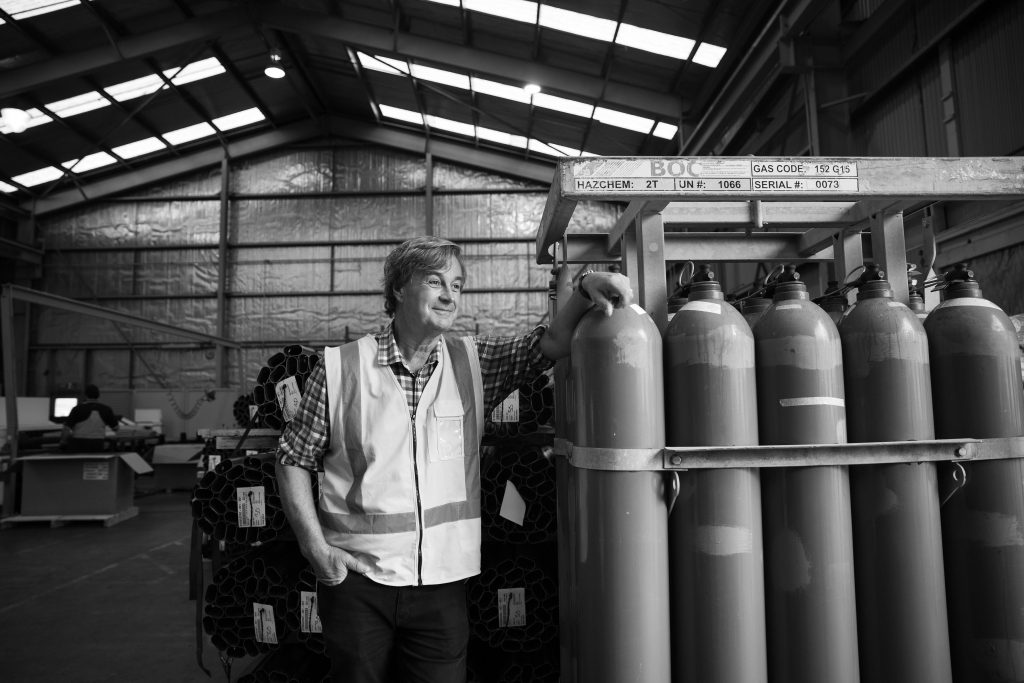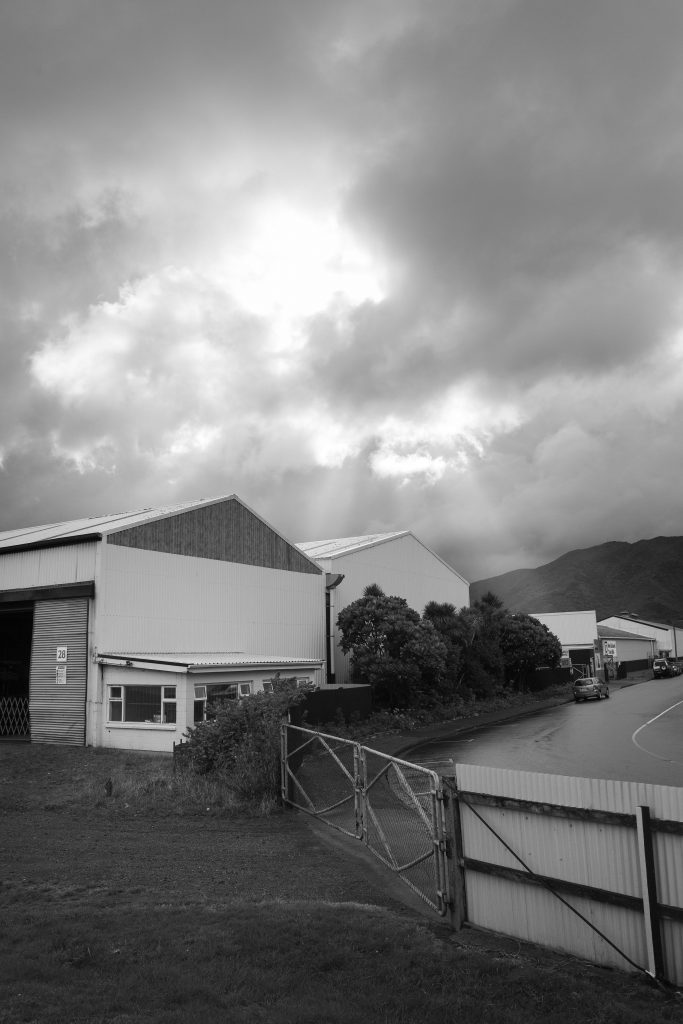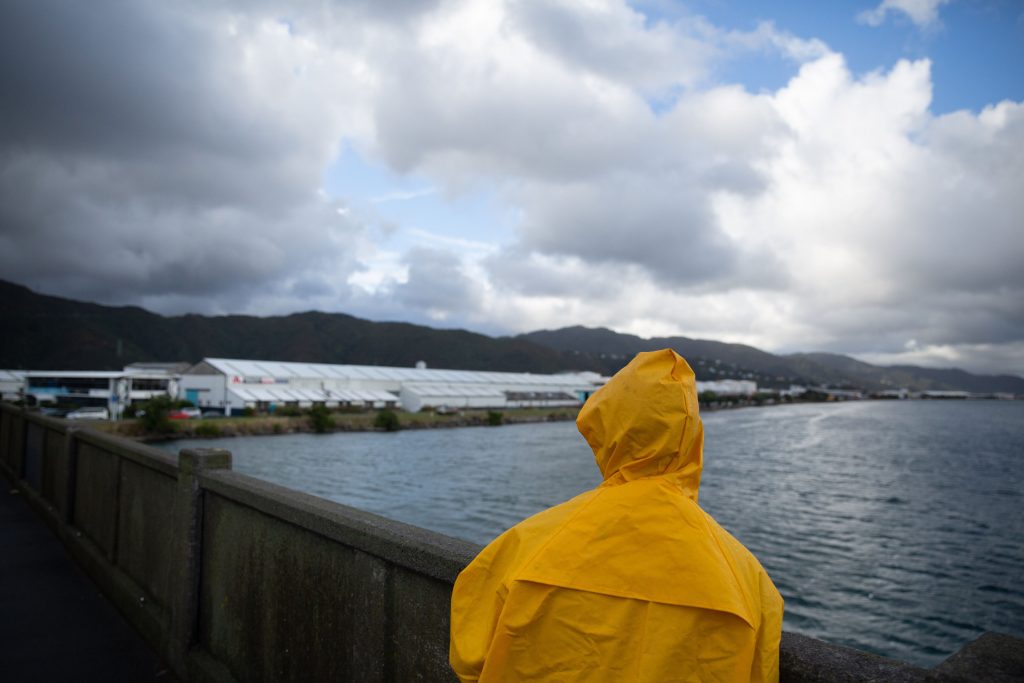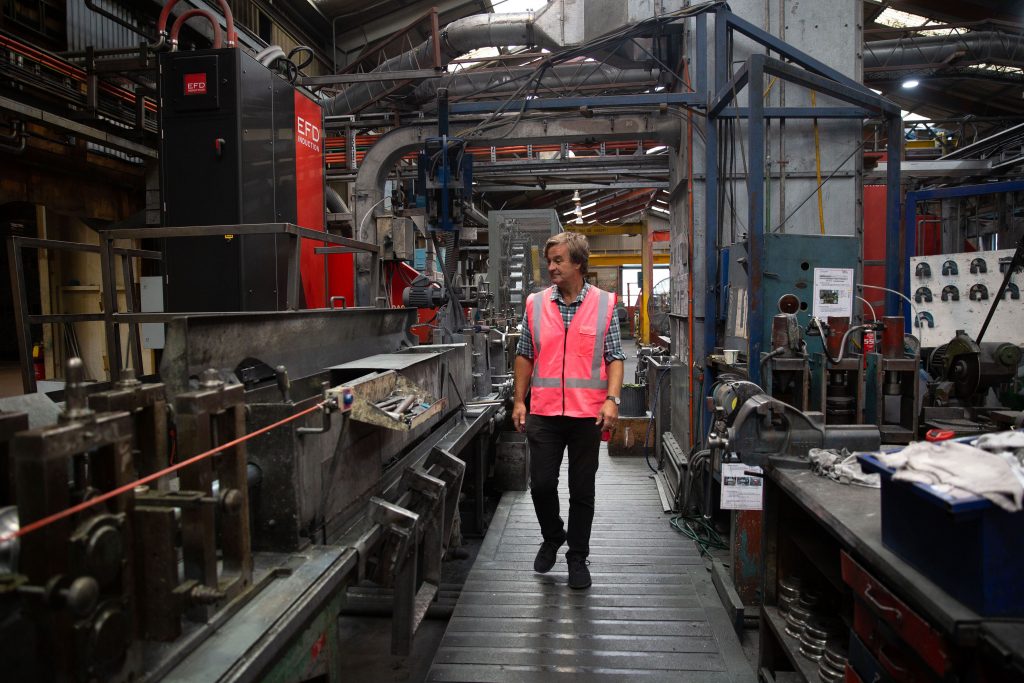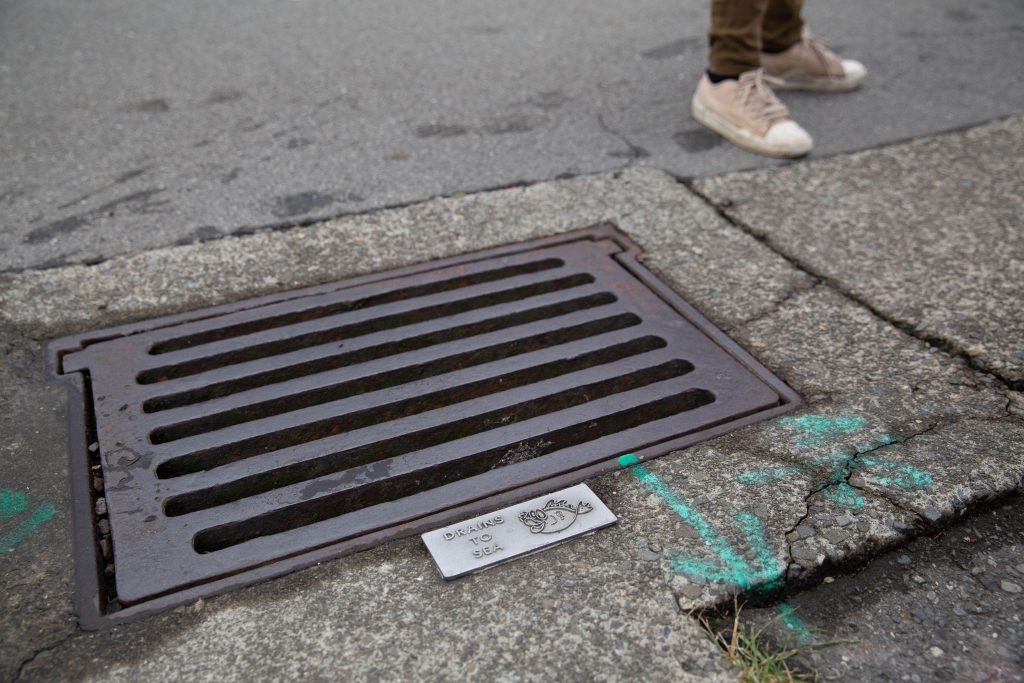Port Road: Climate risks at our urban edges
Port Road: Climate risks at our urban edges
It’s a calm Sunday morning as I arrive at the home of Wellington property investor Paul Robinson, in the thriving beachside community of Plimmerton. Armed with muffins from the local café, I’m greeted by Paul’s friendly border collie Harry, who herds me into a stunning, carefully designed house.
Natural materials enhance the beauty of the coastline. Paths are planted in native coastal grasses and integrate with, rather than seal, the ground underfoot. Cedar cladding is weathering gracefully. The high-spec insulation and double-glazing were revolutionary Northern Hemisphere concepts at the time of building. Concrete flooring retains heat in winter and keeps things cool in summer. In short, the house is efficient, reflecting the Robinson family’s broader approach to property development.

Paul hands me a strong coffee, and we survey the concrete sea-wall separating the property’s edge from the sandy beach, a drop of little less than a metre. This glorious piece of paradise is regularly battered by westerly storms, and on a high tide there’s no beach to speak of.
I first met Paul Robinson several years ago. His family business had grown beyond the work of one person, and his warm optimism belied his personal circumstances. He was grieving, after a significant loss and a transition to a life as a solo dad.
True to character, today Paul is relaxed and cheerful, though he really shouldn’t be – he and his fiancé Julia have family arriving imminently for their wedding the coming weekend.
But he does love talking business.
For Paul, property development and the environment are two entirely reconcilable concepts. Their business provides the Robinsons with an opportunity to create spaces people love to be in and that reduce the environmental impact of the buildings and the industries located within them.
Climate change poses a significant threat to low-lying and coastal urban infrastructure, including commercial and industrial property. These are the buildings in which we work, create, shop, eat out, live and play.
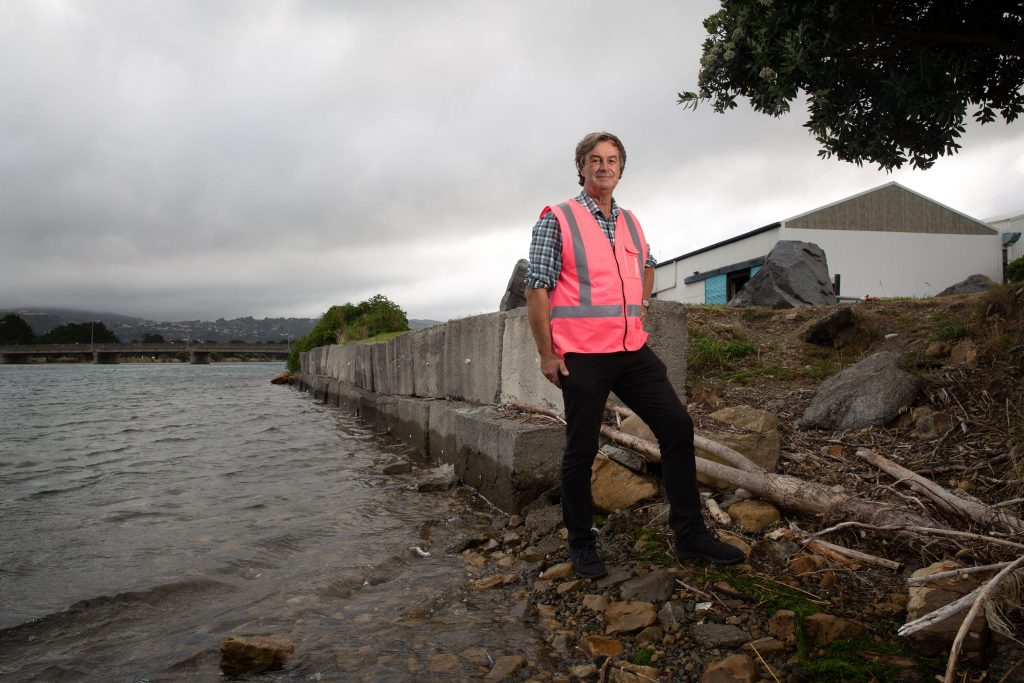
The Robinson siblings, property owners Sam, Paul, Cathy and Meredith, consider ethics and the environment in their decision-making matrix. They favour modern, eco-friendly builds and they retrofit character buildings to improve efficiencies in water, waste and energy. They see the risks of climate change on the horizon. The family are flexing their adaptive muscles on a new purchase in Lower Hutt’s Seaview, a landscape with multiple hazards. This part of the coastline faces the risks of liquefaction and tsunami in the event of an earthquake, flooding from Te Awa Kairangi (the Hutt River) in heavy rain, and will be among the first of Wellington’s suburbs to feel the touch of our rising tides. How the property, as well as the family business, plans for and responds to exceptional, climate-driven weather, will determine the impact these events have on the family’s livelihood, as well as the lives and livelihoods of their tenants and surrounding communities.
And as once-exceptional events become more common, the way we as a nation build climate knowledge and climate resilience into our infrastructure planning, economy and political system will determine whether they are somewhat of an inconvenience, or utterly disastrous. The Robinsons hope their experience and track record have prepared them for their latest challenge. But will triggers and forces beyond their control derail their plans and dreams?
Port Road and Other Exceptional Weather Events
The family’s latest acquisition is a large industrial park on Port Road. The area was once at the centre of New Zealand’s car manufacturing industry and is still chockfull of heavy industry. Most of the park is leased to a steel tube manufacturer, and a serious array of equipment and products are spread across multiple factory floors. The weather’s dramatic when we arrive. Clouds rush through a metallic sky. Rain hits us in sharp bursts. It’s weirdly warm. Port Road is jostled between low-lying Petone and the narrow coastal strip of Eastbourne (which is periodically cut off from adjacent suburbs by slips). The whole coastline groans when storms and heavy rainfall coincide with spring or high tides.
The morning radio bulletin warns of a storm brewing on the West Coast of the South Island. By midday, it’s been termed an “exceptional rain event” and a state of emergency has been declared in the Westland District Council area from Hokitika to Haast. The road between Franz Joseph and Fox Glaciers is closed, and as the day wears on, more slips cause further closures from Makarora to Hokitika, trapping several tourists.
According to reports from NIWA, rain gauges at Milford Sound recorded 357 mm of rainfall in 24 hours, a third of Wellington’s annual rainfall, the sixth wettest day since records began, and the biggest weather event in 20 years. Rivers rose suddenly causing stop banks to burst, and a key bridge on State Highway 6 was washed away.
The extreme weather brought human tragedy, too.
The Cascading Impacts of Climate Change
Weeks later, the event feels eerily like “life imitating research.” The floods took out bridges and roads, cutting off local communities and, for a short time, the main route between Canterbury and the West Coast. Both freight and passenger rail services were cancelled and tourism was hit heavily. Farmers lost precious crops. A disused landfill site was breached. Built on the banks of the Fox River, water sluiced tonnes of rubbish, including hazardous material, out into the river and across 300 kilometres of pristine coastline. Resource that would normally be focussed on such a massive clean-up was initially diverted to the disaster itself.
It will be months and years before the full range of climate impacts can be quantified (though the Westland District Council are already expecting a big clean-up bill). But while the West Coast is nothing if not resilient, as a society we’re not very good at understanding how increasingly frequent weather events “cascade” to affect our wider social and economic activities. We need to get better at understanding the impact of cumulative weather events in the context of a changing climate.
Research led by the Victoria University of Wellington’s Judy Lawrence, “Cascading impacts and implications for Aotearoa New Zealand,” describes exactly the kind of scenario that unfolded on the West Coast. But Lawrence also asks us to imagine what might happen if people are more frequently dislocated from their homes, businesses or communities. She suggests that with repeated flooding, frustration is likely to build, and the cost and disruption of repeated evacuations will cause some services (as well as businesses) to withdraw. She paints a picture of a slowly evolving “natural disaster,” akin to the Christchurch earthquakes, where whole suburbs may well be abandoned, leaving behind vulnerable citizens with nowhere to go.
The research draws on the Circle tool (Critical Infrastructures: Relations and Consequences for Life and Environment), developed by Deltares, a research institute in the Netherlands. The tool helps users identify interdependencies between infrastructure systems. Lawrence hopes it will enable local and regional councils to understand and explore climate impacts that spill from the physical quickly into the social, economic and political spheres. “Unless we do this properly,” Lawrence says, “and if we keep responding only to single impacts and ignoring the cumulative stress and the costs of multiple impacts, our adaptation choices will simply be insufficient. Improving our literacy in how climate change impacts compound and cascade will support more successful adaptation.”
Unless we do this properly, and if we keep responding only to single impacts and ignoring the cumulative stress and the costs of multiple impacts, our adaptation choices will simply be insufficient. Improving our literacy in how climate change impacts compound and cascade will support more successful adaptation.
Judy Lawrence
The Robinsons are applying similar (though more contained) analyses to their own infrastructure. And – as for local and regional councils – tailored information is available that can help them understand the changing risk profile of their immediate environment.
NIWA’s Ryan Paulik, for example, is leading a Deep South Challenge project analysing flood risk across every river in New Zealand and mapping that risk against infrastructure. His research findings will be made available on the open source platform RiskScape (jointly developed by NIWA and GNS Science).
Patrick Walsh, of Manaaki Whenua Landcare Research, is looking more closely at the flood mitigation schemes operated by councils. His research notes that New Zealanders are increasingly moving in to urban, flood-prone areas, yet at the same time, our aging flood-mitigation schemes may be insufficient for future risk. This research is exploring both the costs and benefits of such schemes, in an effort to identify possible improvements in the system.
Tomorrow When the War Began
Back at Port Road, where the storm did not develop into the major event suffered by the West Coast, Paul Robinson and his siblings Cathy, Sam and Meredith, along with their business manager Edith, have donned their armour – hot pink hi-vis vests – to introduce us to their modern war in the built environment. “World War E” is the family’s war on water, waste and energy. It’s their overarching strategy to improve the performance of their commercial properties.
Perhaps unsurprisingly, Paul’s thinking echoes some of the ideas being developed and implemented in the Netherlands, where there’s the strong understanding that we must work with, rather than against, water. “There’s a lot of talk around retreating from the edge,” says Paul. But in the short-term, at least, the Robinsons plan to work on the border between property and water. “I think there is a lot we can do to embrace the coast,” he says.
For the family, 2019 is a year for reconnaissance and assessing baselines. “First,” Paul says, “we’re looking at the three waters – drinking water, stormwater and wastewater – then at what’s happening with energy, and finally what’s happening with waste for each property.” When the family took ownership of Port Road, they assessed the property’s storm and wastewater infrastructure.
“There’s a lot of talk around retreating from the edge… I think there is a lot we can do to embrace the coast.
Paul Robinson
“We think that’s where the immediate problems lie,” says Paul.
“We purchased these buildings knowing there was a risk of inundation from extreme weather events, and we know that risk is probably going to get worse. So, we need to understand the stormwater system really well, and to make sure it’s immaculate. Tenants have been concerned about water coming up through the manholes,” he notes wryly, “which is never ideal.” Paul explains how engineers have already removed five tonnes of gravel from the underground pipes that discharge directly into the Hutt River, which has been eye-opening. “We quickly realised that these stormwater drains have probably never been maintained. Probably, most [property owners] don’t maintain their drains. It’s only if something blocks that people have a look, but there’s a lot of preventative maintenance that can be done.”
Dealing with storm and wastewater is a priority for the family. “We’d like to avoid filling up the Wellington Harbour with brown flush after a wet day,” he laughs, not without irony. Unfortunately, while graphic, such an image is not uncommon along our coastline, particularly in urban or peri-urban coastal areas. Even in Paul’s affluent hometown of Plimmerton, the stormwater system can’t cope in heavy rain and the smell around the stormwater outlet pipes is unpleasant, to say the least.
The asset value of stormwater and wastewater assets in New Zealand is well over $20 billion. This includes 24,000 kilometres of public wastewater networks, with more than 3,000 pumping stations and over 17,000 kilometres of stormwater networks. Much of it, however, was not designed for the trials of climate change, from sea level rise to changes in rainfall frequency and intensity.
A Deep South Dialogue, held in late 2017, brought together water sector representatives with relevant researchers, to explore how climate change will affect our storm and wastewater networks, and to identify critical gaps in our knowledge about them. The resulting dialogue report noted that sea level rise will affect all coastal water infrastructure and will likely result in increasing sewage overflows, the infiltration of wastewater into saltwater, the corrosion of pipes by salt water, and exposure to liquefaction. As many of our water networks rely on gravity to discharge into rivers or the ocean, sea level rise may cause them to fail. Coastal storms may cause electrical failure at treatment plants.
And drought will also affect networks, interfering with gravity systems by slowing flow, leading to blocked pipes. It’s not a comforting picture. The challenges are immense and magnified by the reality that – like the pipes under Port Road – our water infrastructure is in places aging and poorly maintained.
The failure of water infrastructure has obvious and not-so-obvious implications for human health, ecological systems, cultural and recreational spaces, and for our drinking water supply. To create a successful adaptation plan – to make good decisions about maintaining, replacing or upgrading our water infrastructure – we need to understand these direct and indirect risks. We need to be able to imagine the consequences of each decision or indecision.
By looking at this specific network of infrastructure, and working backwards from an “ideal” future, James Hughes of Tonkin+Taylor is trying to discover the performance we require of our storm and wastewater systems in a changed climate. His research project, “Stormwater, wastewater and climate change,” intends to show which types of economic, social, cultural and environmental impacts are likely to be the most serious, and where they might emerge. “We’re aiming to highlight likely hot spots over the short-, medium- and long-term,” Hughes explains. The research will ultimately provide guidance for local government and water sector decision-makers, who are trying to build affordable resilience into our water infrastructure, in the face of future uncertainty.
Paul Robinson makes his feelings on the subject clear. “We’re sitting around in the towns, pointing at the dairy farmers and saying, ‘You bastards, you’re polluting the rivers’. Well, we’re doing exactly the same thing to the Porirua and Wellington Harbours… I think we need to take the plank out of our own eye, before we try and take the speck out of theirs. That might be a good starting point for taking action and moving forward.”
Waterworld
The Robinsons are also looking at ways to detain and retain water onsite. “There are really, really good ideas for harbourside property,” Paul says. “At the moment, greenery is not really valued by owners or occupiers. Let’s make sure we green these sites as much as we can – let’s make them as porous as we can.” Porous surfaces are key to managing excess water in storms and floods. Paul points to the pavement and curb bordering the Port Road property. “If we’re just parking cars,” he says, “let’s see if we can park them on porous surfaces. As the asphalt wears out and requires repair, my thinking is, instead of repairing it, let’s replace it with something better.”
These ideas take Paul somewhat out of the realm of current Deep South Challenge research, but hint towards future research that’s as relevant to the Deep South Challenge as it is to related National Science Challenges (NSCs), like Building Better Homes, Towns and Cities, or Resilience to Nature’s Hazards. The NSCs are keenly aware of the need to complement each other and collaborate on research. Given that climate change has implications for every area of life, from human health to the built environment, from agriculture to technology, the NSCs know that working together is increasingly important. Challenge Director Mike Williams looks forward to a future when Deep South Challenge climate projections – both global and local – are easily accessible for researchers across all fields and areas of interest.
Paul’s optimism, his willingness to try new things, reflects the thinking in another Deep South Challenge research project. Otago University’s Janet Stephenson’s “Climate adaptation, vulnerability and community well-being.” Stephenson’s research is exploring, and documenting, recent successful attempts to engage communities about how they might need to change with our changing climate.
Based mainly in Dunedin, the research surveys council, community and iwi strategies to build resilience into the very fabric of their rohe. The breadth of practical and creative responses to climate change, in the absence of a national adaptation framework, are exciting. Dunedin City Council, for example, are well into imagining what they can do differently to cope with more frequent coastal inundation.
Maria Ioannou, Dunedin City Council’s Corporate Policy Manager, explains how the council is looking into engineering methods used overseas, bringing street gutters to the centre of the road, for example, thereby separating pedestrians and pavements from hazardous water. It’s a small but concrete example of the kinds of strategies the council, and its many communities, are considering, to embed sustainability and adaptation into the city’s regular work plan.
It’s difficult to identify exactly which factor, or “trigger,” is causing some climate-vulnerable communities to face up to climate change more quickly than others. While some communities might be motivated by the desire to take care of their most vulnerable members, others might be triggered to change by, for example, the likelihood they’ll lose insurance at some point in the next few decades.
Deep Impact: Losing Insurance in a Changing Climate
A recent announcement by IAG, New Zealand’s largest insurance group, that they will no longer be taking new business in the Wellington residential market, is the latest in a string of insurance shocks for the region. Long before the ocean laps at the front door, it may well be insurance and credit retreat that forces the hand of the Robinson’s family business.
New Zealand is an unusually well-insured country, so increased hazard risk is putting pressure on insurers, who have already begun to make changes. Lloyds Bank, an international insurance player, includes New Zealand in the top 10 risky places for natural disaster, which – along with climate change – explains why IAG (which owns State, NZI and AMI and underwrites several banking insurance products) has put its investment in Wellington on ice. Late last year, the Insurance Council announced that 2018 had been the second most expensive year for weather-related insurance claims since 1969, second only to 2017. What will the 2019 bill look like?
For a commercial operation like the Robinson’s, the issue of insurance retreat, while frustrating, has not been insurmountable. The family has been dealing with insurance woes in the commercial market since the Christchurch earthquakes, and have since abandoned local brokers and ventured offshore to deal directly with international providers. But for homeowners or small-scale property investors, the prospect of losing insurance is a much more nerve-wracking possibility. Tim Grafton, Insurance Council CEO and Chair of the Challenge’s Representative User Group, notes that the risk of insurance retreat for Seaview and Petone is unusually high.
Challenge climate risk researcher Belinda Storey explains that the key risks for coastal property owners are storminess and sea level rise. Her research project, “Climate change and the withdrawal of insurance,” notes that although we have reliable data for sea level increases over the next few decades, we have very little reliable information about how stormy our coasts will become.
Sea level rise doesn’t just threaten the coast, Belinda explains. Only a small increase in sea level rise enables storms to reach much farther inland.
“In the past,” she says, “insurers have been able to look at the historical record and determine the likelihood of a specific event happening. The problem is that now we’ve got a significant change in the risk.” Insurers are having to reassess their business models and rethink the level of risk they’re willing to bear.
I ask Belinda to give me a sense of the potential timeframes for insurance withdrawal. I don’t even finish my sentence. “Twenty years,” she says. A recent Hutt City Council report put the worst-case scenario at 30 years.
A lot of the discussion around likely climate change impacts pivots around the year 2100. We know, for example, that we’re in for one to four degrees of temperature rise by then, and between one and three metres of sea level rise. But, Belinda argues, it’s very easy for people to ignore or at least delay this kind of discussion, because 2100 feels so far away. People have difficulty planning five years in advance, let alone 80. Belinda says the loss of insurance will bring decisions that we think are far off in the future forward by 50 to 70 years. That’s 2030; 2050 if we’re very lucky.
“A good place to start is with changes we’re most confident about. We’re confident that we’re heading towards a 10cm sea level rise in the next 20 years. We can consider which locations in New Zealand are going to be hit earliest and hardest… which brings us to Wellington. One problem for Wellington is that it also has a low tidal range, meaning that when storm surge comes, there’s more chance it’ll be bigger than a high tide.”
We’re confident that we’re heading towards a 10cm sea level rise in the next 20 years. We can consider which locations in New Zealand are going to be hit earliest and hardest… which brings us to Wellington.
Belinda Storey
There are already places in New Zealand where insurance has become unavailable, but it’s difficult to access that information. Private insurers know who they’re turning down, but researchers and society at large do not have access to this information. Owners may not realise until they go to sell the property that their buyer can’t get insurance.
Belinda’s research is using actuarial analysis to predict which locations are likely to lose insurance. “The thing about insurance is that if you lose it, you don’t want to tell anyone, the insurer doesn’t want to tell anyone, and the council sometimes doesn’t want to tell anyone either… You’ve got all parties wanting to brush it under the carpet, then potential buyers won’t really know either, which is not a good long-term outcome for anyone.”
“There are places in the world that require insurers to notify the regulator when they decline insurance, but we don’t have that here,” says Belinda, who would like to see more information made publicly accessible. Belinda believes that applying this model in New Zealand could make a significant difference to public planning, and would enable society to consider how the risk is changing.
So who bears responsibility for risk in all of this? Whether development is large-scale coastal or riverside property, or a beach side family bach, it’s all forging changes in the infrastructure on our coastline. Decisions are being made within the frameworks set by local and central government.
And according to Deep South Challenge researcher Lisa Ellis, from the University of Otago, within our current framework, “individual members of our most vulnerable communities will bear the burden of risks they could not have foreseen.”
“If we do not take action,” Ellis argues, “we can expect delayed, expensive and uneven responses to these new natural hazards; reactive responses to challenges that could have been mitigated or prevented; emergency measures imposed from above rather than community-led long-range planning; missed opportunities to enjoy the co-benefits accruing from long-term adaptation planning; and overall, a transfer of risk from the least to the most vulnerable.”
Ellis’s Challenge project, “How should the risks of sea-level rise be shared?” has found that for any new build in risky locations, “the government – that is, effectively, everyone – will be expected to cover losses for development that is already predictably risky.”
There’s no current international best practice for climate adaptation. If we do this well, there are substantial co-benefits society-wise, especially for achieving equitable outcomes. So, let’s think of it as an opportunity.
Lisa Ellis
Ellis and her research team concluded that, “The most important immediate step New Zealand can take toward an ethically robust sea-level rise policy is to bring certainty and consistency into the legislative framework.” They also argued that there needs to be wider consideration given to the ethics and values we want to follow as we adapt, to ensure that the highest costs of climate change are not transferred to the most vulnerable. “There’s no current international best practice for climate adaptation,” Ellis said, in a recent Deep South Challenge online seminar. “If we do this well,” she continued, “there are substantial co-benefits society-wise, especially for achieving equitable outcomes. So, let’s think of it as an opportunity.”
The Day After Tomorrow
After their water and waste audit, the Robinsons will turn their attention to the question of energy. The Port Road buildings consume $240,000 worth of energy a year. An initial audit identified the potential to save over $100,000 worth of electricity per year, by doing relatively simple things like replacing or modifying the site’s transformers. “We’ll also go through and replace over a hectare or so of high bay metal fluoride lighting with LED,” Paul says. But the final stage of the Robinson family’s World War E will be a change in the way they organise themselves. In the future, instead of “property manager,” Paul would like to shift into environmental management, communicating the priorities of their business. “All of a sudden, renewing leases and fixing leaking roofs [will become] ancillary to environmental and social management.”
There may well be a metaphor in here for the way we need to change our collective thinking in relation to our stewardship of our built environment in a changing climate.
“My brother Sam and I started a company in the mid-1990s and bought the old Briscoes building in Porirua,” now the site of the very popular Peppermill Café. “Our first goal, all those years ago, was based around one simple question. ‘How do we get this business to a sustainable level… to ensure it’s resilient against economic shock.’”
A building is inherently humans + infrastructure. Buildings provide for people and livelihoods, and should primarily consider the people who work, live and socialise within them. Protecting both the past and the future is a challenge the Robinsons are willing to tackle. A few decades on, their business is thriving, with eight large commercial properties in their portfolio, including Porirua’s first Greenstar building.
They also own the Woolstore Design Centre on Wellington’s Thorndon Quay, which has been designed to bring people together, through great social spaces, excellent food and an impressive collection of New Zealand art. “It gives the place a spirit,” Paul says.
There are many parallels between the kind of planning the Robinson family are considering and the questions that councils and central government must consider in their policy development. Adaptation must take not just hard infrastructure into account but must ensure that the future we plan for is built for human communities and enables us to thrive.
Don’t underestimate the risk… Make your decisions considering that the extremes could happen, because at some point they will.
Belinda Storey
At the most basic level, however, Belinda’s advice for homeowners and property developers alike, is clear, “Don’t underestimate the risk… Make your decisions considering that the extremes could happen, because at some point they will.”
This story first appeared in Kia Urutau | Adapt, the May 2019 magazine of the Deep South Challenge.
STORYTELLING
FOR CHANGE
The Deep South Challenge has always experimented with supporting or initiating different kinds of storytelling to drive climate adaptation. These long-form magazine features allow us to weave different research projects into new patterns, helping us to see our research in different ways.
